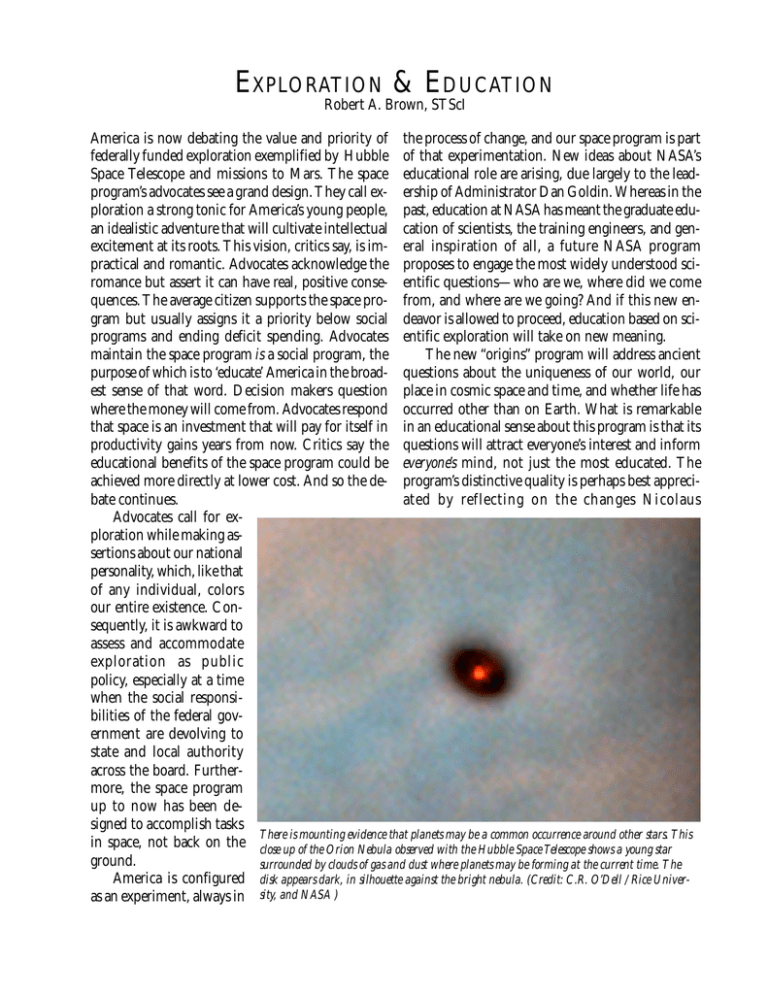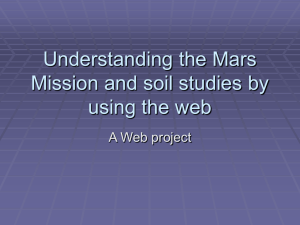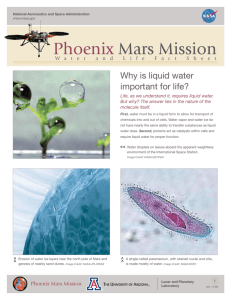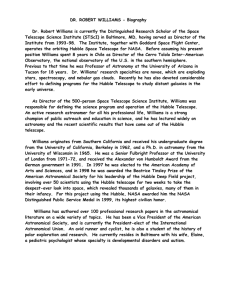E & E XPLORATION DUCATION
advertisement

EXPLORATION & EDUCATION Robert A. Brown, STScI America is now debating the value and priority of the process of change, and our space program is part federally funded exploration exemplified by Hubble of that experimentation. New ideas about NASA’s Space Telescope and missions to Mars. The space educational role are arising, due largely to the leadprogram’s advocates see a grand design. They call ex- ership of Administrator Dan Goldin. Whereas in the ploration a strong tonic for America’s young people, past, education at NASA has meant the graduate eduan idealistic adventure that will cultivate intellectual cation of scientists, the training engineers, and genexcitement at its roots. This vision, critics say, is im- eral inspiration of all, a future NASA program practical and romantic. Advocates acknowledge the proposes to engage the most widely understood sciromance but assert it can have real, positive conse- entific questions—who are we, where did we come quences. The average citizen supports the space pro- from, and where are we going? And if this new engram but usually assigns it a priority below social deavor is allowed to proceed, education based on sciprograms and ending deficit spending. Advocates entific exploration will take on new meaning. maintain the space program is a social program, the The new “origins” program will address ancient purpose of which is to ‘educate’ America in the broad- questions about the uniqueness of our world, our est sense of that word. Decision makers question place in cosmic space and time, and whether life has where the money will come from. Advocates respond occurred other than on Earth. What is remarkable that space is an investment that will pay for itself in in an educational sense about this program is that its productivity gains years from now. Critics say the questions will attract everyone’s interest and inform educational benefits of the space program could be everyone’s mind, not just the most educated. The achieved more directly at lower cost. And so the de- program’s distinctive quality is perhaps best apprecibate continues. ated by reflecting on the changes Nicolaus Advocates call for exploration while making assertions about our national personality, which, like that of any individual, colors our entire existence. Consequently, it is awkward to assess and accommodate exploration as public policy, especially at a time when the social responsibilities of the federal government are devolving to state and local authority across the board. Furthermore, the space program up to now has been designed to accomplish tasks There is mounting evidence that planets may be a common occurrence around other stars. This in space, not back on the close up of the Orion Nebula observed with the Hubble Space Telescope shows a young star ground. surrounded by clouds of gas and dust where planets may be forming at the current time. The America is configured disk appears dark, in silhouette against the bright nebula. (Credit: C.R. O’Dell / Rice Univeras an experiment, always in sity, and NASA ) Copernicus inspired in the human mind almost 500 years ago. The Copernican revolution was not one but two revolutions. The first, the one with which we are most familiar, placed the Earth in its proper place in the skies, orbiting the Sun, rather than the other way around. This master-stroke engendered science as we know it, for the scientific method was developed in the pro- During the first few billion years after the Big Bang, the expanding universe developed gross structure cess of sorting out that later divided into galaxies, in a series of steps that have not yet been observed. The upper panel where the planets are shows the early structure at a lookback time about 99.9% the age of the universe, as seen by the Cosmic in three dimensional Background Explorer telescope. The lower panel shows the most remote galaxies yet observed by the space. Important Hubble Space Telescope, back to about 80-90% of the time since the Big Bang. The successor telescope to Hubble could explore the first 10% of time, when aptiogalaxies like our Milky Way were formed. tools of science, such (Credits: Robert Williams and the Hubble Deep Field Team (STScI) and NASA. DMR image courtesy as the calculus, were of the COBE Science Working Group, and NASA.) devised to assist the inquiry. The second Copernican revolution, however, af- telescope being designed by NASA to look deep into fected vastly more people than the first, as it altered space, back in time, to the earliest galaxies like our their worldview. If the Earth was just another planet, Milky Way. This research will enable us to follow then the human experience of Earth might or might the progression of events, starting with the first ornot make it different from other planets: life, even ganization of matter after the Big Bang, giving rise civilization, might have arisen elsewhere. This rami- to our galactic home. fication of science has played itself out in a half The question of whether life arose elsewhere in millenium of robust philosophical dispute about the the Solar System is to be addressed by missions to uniqueness of Earth and the place of the human story Mars to look for fossil life. The definitive search will in the history of the universe. That dispute is culmi- probably involve human rock hounds exploring the nating at the current time, as part of its origins pro- surface of Mars. It is already widely accepted that gram, for NASA is designing a telescope to discover Mars had a thicker atmosphere in an earlier era, and and study other worlds orbiting nearby stars. It will space probes have taken pictures of erosion by flowbe able to measure the properties of these other plan- ing water on the surface. These factors, combined ets, including whether they are Earth-like and con- with recent evidence that life appeared in the very ducive to life. early history of Earth, encourages the idea that life An important extension of the Copernican revo- may have started on Mars only to be terminated when lutions is the question of our place in cosmic time the environment changed to the dry and hostile conand space. This question is now accessible to another ditions observed today. As it takes on the exciting origins research proAdmittedly, such opportunities to influence any gram, the space exploration community recognizes culture’s worldview or ideology must not be taken how important it is to explain its motivations, goals, on without circumspection, and it would certainly be inappropriate for our government to attempt the task of informing people what they should or should not believe about their origins and place in the universe in a religious sense. Nevertheless, not to inquire of nature—not to look for Earth-like planets around other stars, not to look at the formation and evolution of galaxies, and not to seek fossil life on Mars—would be a perilous and sad choice for a society such as ours that is committed to truth, objective thinking, and techLiquid water is thought to be required for life to arise in a planetary environment, and it was nological progress. Indeed, present on Mars at an earli er time. This Viking orbiter image shows a network of interconnectthe very design of Ameriing dry river beds in a pattern of branching channels characteristic of a network that drains precipitation. This is the strongest evidence that Mars’ atmosphere must once have been warmer can government is a and of higher pressure than it is now. (Credit: From Mars Digital Image Map, image processing monument to the benefit by Brian Fessler, Lunar and Planetary Institute) of increasing and applying and results to the society that supports its research. new knowledge. Soon, as budget battles over NASA’s The necessity of doing so is especially acute because, funding begin, the same democratic institutions that as we draw nearer to answering some of humanity’s arose from that principle will choose whether to shed ancient questions, the competition for resources will new light on the origins of human experience in its be stronger than at any time in the last half century. most universal context—or to avoid the challenging America’s space scientists are also keenly aware they task. bear the national mantle of exploration, which so Exploration and discovery are the pure expresresonates with our frontiering history. sion and due consequence of freedom. This It is not often given to scientific exploration to intellecual duet has been the heartbeat of our nation inform directly a culture’s beliefs, and an average since its inception. Pioneers cultivated this principle person’s self understanding. We know about the in the wilderness, where it was reinforced by the Copernican revolutions, but there are other histori- abundance of a continent. The idea sprung roots in cal examples as well. Darwin’s voyage on the Beagle, how Americans view learning: from George Washwhich led to the theory of evolution, is one. The ington onward national leaders have supported the Apollo missions to the Moon are perhaps another, gathering and dissemination of knowledge as essenfor the magnificent pictures of the Earth as an island tial to the conduct of democracy, and to elevating of life in space produced the indelible impression the thoughts of individual citizens. Today, innovathat our common inheritance and destiny overarches tion and experimentation are ideals and icons of our all the divisions and distinctions between the people free enterprise system, affecting our approach to of the world. child-rearing and education, and our arts, literature, and national mythology. Freedom in all guises is our national personality. For 200 years, America has reaped the benefits of this premise that freedom—liberty to explore and discover in all parts of life, nature, and thought—is superior to any other principle. Our democracy has invested public funds to open frontiers that lie beyond the grasp of individual Americans. Presidents Jefferson, Madison, and Monroe approved the building of the National Road from Maryland to the Ohio River to open up the West for pioneers. Franklin D. Roosevelt—and all succeeding Presidents and Congresses—have believed science to be a metaphorical frontier that has a significance for modern America comparable to that of the West in the eighteenth and nineteenth centuries. Most recently, our government opened space to American pioneering. Since Eisenhower, each of the Presidents and Congresses has viewed space, like science, as a frontier ideally suited to America. Exploration and discovery—these crown jewels of America—are epitomized today in the federal space and science programs. The debate is whether to hold them to the light or risk losing their magic and power. America might choose to leave these activities to other nations because it no longer has faith in the intrinsic value of new knowledge, or because it believes itself not sufficiently clever to exploit wildernesses of the intellect. But just as it does for individuals, personality distinguishes one nation from another, and in both cases it is a key to success and prosperity. I believe America will not neglect these investments because we value what makes Americans and American ideas different. I believe we will not neglect to pass these frontier opportunities on to our children. NASA and the community of space science explorers are making an innovative contribution to the great debate on space exploration by coming forward with a unique program to educate and inform the entire public on the deepest and most widely understood questions of our existence: the questions of our origins. In doing so, they open the floor to whole communities of educators, philosophers, theologians, artists and authors, as well as private citizens, who will voice their opinions on the value of these learning opportunities. And how to take best advantage of them. Robert A. Brown Space Telescope Science Institute 3700 San Martin Drive Baltimore, MD 21218 To be published in Ad Astra Volume 8, No. 3, May/ June 1996. Robert Brown is an astronomer at the Space Telescope Science Institute in Baltimore, where he heads the Special Studies Office. He is a former NASA project scientist for Hubble Space Telescope. Brown is a planetary scientist, and the discoverer of the emission cloud around Jupiter’s satellite, Io. His current observing program is to detect large planets around young stars directly using Hubble and groundbased infrared telescopes. For the last ten years, Brown has worked on the problem of connecting education and space in an effective manner.





